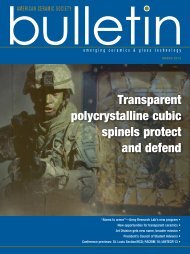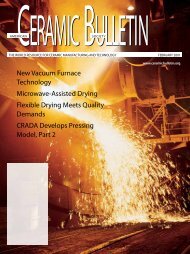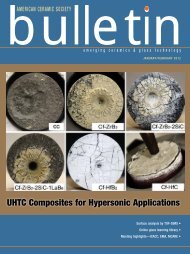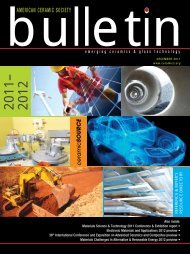American Ceramic Society Bulletin
American Ceramic Society Bulletin
American Ceramic Society Bulletin
Create successful ePaper yourself
Turn your PDF publications into a flip-book with our unique Google optimized e-Paper software.
In the next year I hope to make the<br />
transition from materials to medicine.<br />
As an undergraduate student studying<br />
materials science and engineering at<br />
Pennsylvania State University I am<br />
planning on applying to medical school<br />
next year.<br />
My interest in biomaterials led me to<br />
the MatSE department where I began<br />
research my freshmen year. By working<br />
with a postdoctoral researcher, I<br />
learned about the different characterization<br />
techniques for testing polymeric<br />
artificial heart membranes. A Research<br />
Experience for Undergraduates opportunity<br />
in soft materials at Penn State gave<br />
me the opportunity to develop my own<br />
investigation. I worked collaboratively<br />
with the MatSE and the food science<br />
departments to create complexes using<br />
amylose isolated from potatoes. My<br />
senior thesis project, developed from<br />
this research, has possible implications<br />
as a drug delivery system.<br />
I have enjoyed my exposure to biomaterials<br />
in my coursework. My junior<br />
design class project focused on developing<br />
a technique to prevent degradation<br />
of colloidal nanoparticles used as<br />
deliver agents for chemotherapeutics.<br />
An elective course also gave me exposure<br />
to materials selection criteria for<br />
implant devices and practical medical<br />
applications.<br />
But, I wish that a stronger emphasis<br />
on healthcare applications of materials<br />
could be incorporated into traditional<br />
materials science and engineering<br />
ceramics courses. Materials science and<br />
engineering may soon be responsible for<br />
helping to solve some modern medical<br />
52<br />
deciphering the discipline<br />
Biomaterials<br />
innovation: Student<br />
exposure to ‘bio’ and<br />
health fields needed<br />
dilemmas. We are pushing the boundaries<br />
to find more effective treatments<br />
for cancer and HIV. Other serious<br />
health concerns include the overuse<br />
of antibiotics, leading to drug-resistant<br />
strains of bacteria, which pose a challenge<br />
to pharmacologists. The expertise<br />
of materials scientists and engineers<br />
may offer new insights to treat these<br />
rapidly evolving bacterial strains. . For<br />
example, creating more effective ways<br />
of manufacturing drugs and providing<br />
targeted in-vivo delivery may rely on<br />
viewing medicine from a nanomaterials<br />
perspective.<br />
Materials scientists and engineers<br />
are finding solutions to offer medicine<br />
worldwide. One of the biggest problems<br />
with diseases such as malaria and tuberculosis<br />
is distributing unstable pharmaceuticals<br />
or vaccines. Innovations in<br />
materials science and engineering may<br />
soon find ways to store vaccines in hot<br />
climates or increase the stability time of<br />
sensitive medicine while driving down<br />
costs. Glass or piezoelectric materials<br />
may provide imaging techniques that<br />
decrease radiation exposure while providing<br />
higher image quality. And, there<br />
are endless possibilities for tissue engineering<br />
in the future.<br />
I wish that materials science and<br />
engineering curriculums reflected these<br />
exciting opportunities and focused more<br />
heavily on collaboration with biological<br />
fields. Surprisingly, I have been required<br />
to take classes in all of the basic sciences<br />
except biology. And, I know from<br />
speaking with students in materials<br />
programs across the country, that this<br />
practice is common. But, incorporating<br />
an introductory course in biotechnology,<br />
biochemistry, molecular biology or<br />
agriculture sciences could help expose<br />
students to an entirely different side of<br />
materials that is often underemphasized<br />
in traditional ceramics curriculums. We<br />
know that organisms can design and<br />
build materials with extreme precision<br />
Erica Marden<br />
Guest columnist<br />
and that some organic materials exceed<br />
the mechanical properties we can<br />
design. Studying these biological systems<br />
may highlight new opportunities<br />
for material advancements.<br />
I am hopeful that the construction<br />
of a new Millennium Science Complex<br />
at Penn State will encourage more collaboration<br />
and coursework with the<br />
biological sciences. The building will<br />
house faculty from the MatSE, chemistry<br />
and biology departments under<br />
one roof. Characterization institutes<br />
from each department will be housed<br />
in a central location, and hopefully this<br />
proximity will encourage research and<br />
coursework collaborations. Many other<br />
schools have begun to establish interdisciplinary<br />
graduate school programs<br />
that focus on combining expertise in<br />
materials with computer science, math,<br />
physics, chemistry or biology. Ideally,<br />
these programs will soon carry to the<br />
undergraduate level so that students<br />
may have more flexibility in choosing<br />
ceramics courses that provide a broader<br />
perspective on biological applications.<br />
I am pursuing medicine to incorporate<br />
my interest in science and technology<br />
with my love of interacting with<br />
and helping people. I am confident that<br />
my strong education in materials science<br />
and engineering will provide me<br />
with a unique perspective on modern<br />
medicine. I am optimistic that my work<br />
and plans will lead me into medicine<br />
and, eventually, collaborations on<br />
future medical materials. Hopefully, I<br />
can add to the amazing biomaterial and<br />
biomedical work by ceramists worldwide<br />
that needs to be reflected in future<br />
undergraduate ceramic curriculums.<br />
Marden is a senior at Penn State.<br />
She is the vice president of her<br />
college’s student council and the<br />
secretary of her Keramos chapter.<br />
<strong>American</strong> <strong>Ceramic</strong> <strong>Society</strong> <strong>Bulletin</strong>, Vol. 90, No. 4






